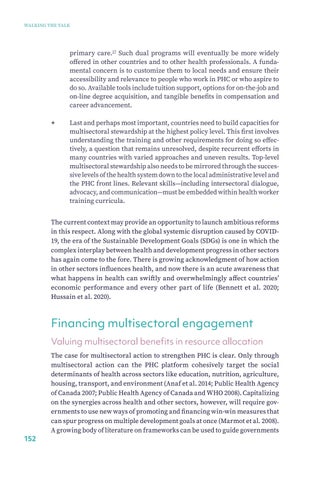WALKING THE TALK
primary care.17 Such dual programs will eventually be more widely offered in other countries and to other health professionals. A fundamental concern is to customize them to local needs and ensure their accessibility and relevance to people who work in PHC or who aspire to do so. Available tools include tuition support, options for on-the-job and on-line degree acquisition, and tangible benefits in compensation and career advancement. ++
Last and perhaps most important, countries need to build capacities for multisectoral stewardship at the highest policy level. This first involves understanding the training and other requirements for doing so effectively, a question that remains unresolved, despite recurrent efforts in many countries with varied approaches and uneven results. Top-level multisectoral stewardship also needs to be mirrored through the successive levels of the health system down to the local administrative level and the PHC front lines. Relevant skills—including intersectoral dialogue, advocacy, and communication—must be embedded within health worker training curricula.
The current context may provide an opportunity to launch ambitious reforms in this respect. Along with the global systemic disruption caused by COVID19, the era of the Sustainable Development Goals (SDGs) is one in which the complex interplay between health and development progress in other sectors has again come to the fore. There is growing acknowledgment of how action in other sectors influences health, and now there is an acute awareness that what happens in health can swiftly and overwhelmingly affect countries’ economic performance and every other part of life (Bennett et al. 2020; Hussain et al. 2020).
Financing multisectoral engagement Valuing multisectoral benefits in resource allocation
152
The case for multisectoral action to strengthen PHC is clear. Only through multisectoral action can the PHC platform cohesively target the social determinants of health across sectors like education, nutrition, agriculture, housing, transport, and environment (Anaf et al. 2014; Public Health Agency of Canada 2007; Public Health Agency of Canada and WHO 2008). Capitalizing on the synergies across health and other sectors, however, will require governments to use new ways of promoting and financing win-win measures that can spur progress on multiple development goals at once (Marmot et al. 2008). A growing body of literature on frameworks can be used to guide governments


